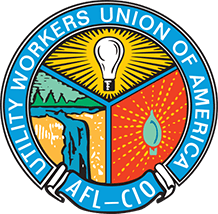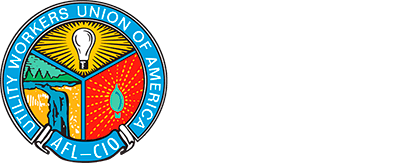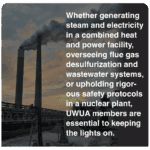 UWUA members play a critical role in producing the electricity that powers
UWUA members play a critical role in producing the electricity that powers  communities across the nation, working across a wide range of energy sources. From large-scale coal plants like Ohio Valley Electric’s Kyger Creek Station, to modern natural gas and cogeneration facilities such as Vicinity Energy’s Kendall Plant, and high-capacity nuclear plants like DTE Energy’s Fermi Nuclear Power Plant, UWUA members ensure reliable, efficient, and safe energy production every day.
communities across the nation, working across a wide range of energy sources. From large-scale coal plants like Ohio Valley Electric’s Kyger Creek Station, to modern natural gas and cogeneration facilities such as Vicinity Energy’s Kendall Plant, and high-capacity nuclear plants like DTE Energy’s Fermi Nuclear Power Plant, UWUA members ensure reliable, efficient, and safe energy production every day.
They work around the clock, managing complex equipment and control systems while maintaining a steadfast focus on safety. Whether generating steam and electricity in a combined heat and power facility, overseeing flue gas desulfurization and wastewater systems, or upholding rigorous safety protocols in a nuclear plant, UWUA members are essential to keeping the lights on.
The following profiles highlight three dedicated professionals who exemplify the skill, commitment, and teamwork that UWUA members bring to the nation’s energy infrastructure, showcasing the variety and complexity of modern electric power production.
Nick Major
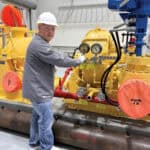 DTE Energy Fermi Nuclear Plant
DTE Energy Fermi Nuclear Plant
Non-Licensed Operator (NLO)
Local 223
Fermi employs about 250 Local 223 members, with roughly 35 to 40 of us serving as non-licensed operators (NLOs). The plant produces 1,100 megawatts of electricity, accounting for about 20% of DTE’s total power production. The reactor runs continuously except during a 35-day refueling outage every two years.
Our work schedule runs on a five-week cycle that rotates between day and night shifts, with a mandatory training week every fifth week. In nuclear power, continuous education and preparedness aren’t just encouraged — they’re required. The schedule may seem complex, but it’s designed to ensure continuous coverage and safety.
While I don’t hold a federal license like the Licensed Nuclear Operators (LNOs) or Senior Reactor Operators who manage the reactor core, my role as an NLO is just as crucial to the safe and continuous operation of the plant. To become an NLO, you complete a year-long internal training program. This combines classroom instruction with hands-on experience specific to Fermi. You can’t just be trained anywhere and work here; every nuclear plant is unique, and you must know the ins and outs of this plant.
On a typical shift, there are about 150 people on site, including licensed operators, NLOs like me, radiation protection staff, and maintenance personnel. Maintenance crews primarily work on day shifts, while at night we keep a smaller team on standby for emergencies. Each shift requires at least six NLOs.
Every shift starts with a turnover meeting where the outgoing crew briefs us on ongoing work, issues, and the plan for the shift. It includes operations, chemistry, and radiation protection teams to ensure everyone is aligned. Afterward, four of us NLOs head out on rounds, observing the plant — listening, smelling, and looking for anything unusual — while recording data such as pressures, temperatures, and flow rates. The other two NLOs focus on specialized duties, including testing emergency systems. For example, we might test the standby feed water system — an electric pump that adds water to the reactor in emergencies — verifying that it meets pressure and flow requirements.
Whether on days or nights, much of the rest of my shift revolves around tagging protection. NLOs prepare and maintain a safe environment for maintenance crews by isolating potential hazards — electrical, steam, water, or mechanical energy — before work begins. We “tag out” equipment by shutting valves, opening and disconnecting breakers to prevent accidental energizing, and placing warning tags indicating the equipment is off-limits until maintenance is complete.
It’s physical work across a large plant with three main buildings: reactor, turbine, and auxiliary, plus a separate radioactive waste facility. We manage hundreds of pieces of equipment — some small, some enormous — organized into complex, layered systems.
NLOs don’t perform the actual maintenance; we ensure maintenance personnel work safely and the plant stays compliant with regulations. Some equipment must be brought back online within strict time frames, so we coordinate carefully. We also manage plant configuration, ensuring alternatives are ready when one component is offline. This redundancy is built into every system. For example, if one of the four emergency diesel generators is down for maintenance, the other three must be ready immediately. This is critical for safety and regulatory compliance.
When I’m not doing tag outs, I’m preparing for future maintenance or the next refueling outage. Planning starts as soon as the last outage ends — even though it’s two years away.
The plant’s safety and smooth operation depend on teamwork, attention to detail, and strict adherence to protocols. Being a non-licensed operator at Fermi has been a challenging and rewarding career — one I’m proud to have been part of for 25 years.
Kaela Osborne
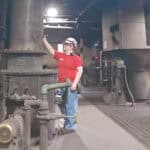 Ohio Valley Electric Corp. Kyger Creek Power Plant
Ohio Valley Electric Corp. Kyger Creek Power Plant
Auxiliary Equipment Operator (AEO)
Local 430
I’ve worked at Kyger Creek Power Plant in Cheshire, Ohio, for five years. It’s a coal-fired plant along the Ohio River with West Virginia just across the water. When it began operation in 1955, Kyger Creek and its twin Clifty Creek Station in Indiana were among the largest power plants ever built by private industry. Together, they powered atomic enrichment efforts during the Cold War. Today, Kyger Creek continues to serve the public power grid under PJM, with a total capacity of 1,085 megawatts from five units.
I started as a junior Auxiliary Equipment Operator (AEO) and after probation was promoted to full AEO. No special license is required, but you must pass the Moss-POSS test — a standardized industry exam assessing mechanical aptitude, math, reading, and problem-solving skills — to ensure you’re prepared for the technical challenges of the job.
There are about 30 AEOs here across four rotating 12-hour swing shifts. Whether it’s day or night, the work is mostly the same. The plant operates in four main areas: inside the plant, the Flue Gas Desulfurization (FGD) system, wastewater treatment, and the coal yard. I’ve spent most of my time in FGD and wastewater but have worked around the plant enough to understand the entire process.
Coal arrives by barge and is unloaded into our coal yard. It travels via a conveyor system into the plant’s “tripper room”— a long corridor serving all five generating units. From there, the coal moves into bunkers that feed pulverizers, which grind it into a fine powder. This pulverized coal is injected into the boilers, where it burns at high temperatures, heating the water circulating inside and turning it into steam. The steam is directed into turbines, spinning blades much like wind turning a windmill. The spinning turbine drives a generator that produces electricity. Surrounding each boiler are about 10 floors of equipment, controls, and piping — a massive, complex system that must work flawlessly.
The gas produced by the plant is sent to the FGD area, where it is cleaned before being released into the atmosphere. Flue gas passes through fans into a jet bubbling reactor, a large limestone slurry tank, where sulfur and other harmful substances are scrubbed out. The resulting slurry is treated and dewatered. The leftover material is gypsum — a byproduct sold to drywall manufacturers.
Recently, I’ve focused more on wastewater treatment, critical for compliance and conservation. Water from across the plant flows into the system, where I inspect pumps, motors, and tanks. We use gravity and chemical binders to separate solids, which are pressed into cakes for landfill. Cleaned water is reused or sent to an evaporation pond. We’re moving toward a closed-loop system and installing a new bioreactor—an EPA requirement using microorganisms to remove mercury and silica — scheduled for January 2026.
Each shift starts with a changeover from the previous team. We review any equipment, chemistry, or operational issues, and I stay in constant communication with the lab to keep everything within required ranges. Besides wastewater, I’m also responsible for our dry fly ash system, which handles another byproduct of combustion. This material is collected and shipped offsite for reuse.
Alongside my AEO duties, I serve on the plant’s first responder and confined space/rope rescue squads, and, like all able-bodied operations staff, am part of the fire brigade.
Once you find the area that suits you — whether inside the plant, FGD, or wastewater — you stick with it and become an expert. I’ve found my spot in FGD and wastewater, and I’m proud to contribute to the plant’s success every day.
Mike Fitzgerald
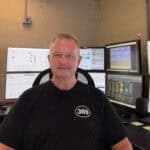 Vicinity Energy Kendall Station Cogeneration Plant
Vicinity Energy Kendall Station Cogeneration Plant
Lead Power Plant Technician (LPPT)
Local 369
I’ve been working at Kendall Station since 1989, and through all the changes — ownerships, upgrades, new systems — two things have always stayed the same: we’ve always been called Kendall Station, and we’ve always been members of the UWUA. We have 31 union positions that operate and maintain the plant.
Today, I serve as a Lead Power Plant Technician (LPPT) in the operations department. I started in operations, spent nearly three decades in maintenance, and rejoined operations in 2022. The job is demanding and constantly evolving, but I enjoy it. It keeps me sharp, and I work with a great crew. I’ve also been the chief steward at Kendall since 2012.
Built in 1948, the facility originally ran on coal. Over time, it transitioned to oil, and now runs primarily on natural gas, with low-sulfur diesel as backup. We produce roughly 245 MW of electricity. Kendall is a combined heat and power facility: we don’t just generate electricity — we capture and reuse waste heat to produce steam, which we deliver to customers in Boston and Cambridge through a 26-mile underground system.
We operate 24/7 on rotating eight-hour shifts. Each includes two LPPTs and two Power Plant Tech A Operators (AO). One LPPT works in the control room, monitoring and adjusting operations through computer screens. The other handles floor operations — equipment checks, lock-out/tag-out procedures, troubleshooting, and more. My partner and I alternate roles every other shift to stay proficient.
The shift begins with a full review of all systems — nine screens, one by one — which takes about an hour. From there, it’s either a quiet day of monitoring or a busy one adjusting load based on ISO New England input, which dictates our generation output remotely via RTU signals. We monitor the Desired Dispatch Point for updates that can come as often as every five minutes and make changes carefully to keep systems balanced.
On the floor, there’s always something happening. A combustion turbine — essentially a giant jet engine — burns gas and spins a generator to produce electricity. Its exhaust powers a heat recovery steam generator, producing steam that drives a back pressure turbine to generate more electricity and provide steam for customer use. It’s cogeneration in action: one fuel source, two outputs, high efficiency.
We also have two power boilers, two auxiliary boilers, and a 42 MW electric boiler, which came online in 2024. Vicinity plans to add a 35 MW industrial-scale heat pump complex by 2027. During high-load periods, we fire the power boilers to maintain steam pressure and load. Even on lighter days, we cycle them to keep them ready.
When I’m working the floor, I assist the two AOs, who split responsibilities for the plant — one focusing on water treatment, the other on general systems. I often do a walkaround myself to keep eyes on everything. Safety is central to our work, with lock-out/tag-out procedures a constant part of operations. The LPPT oversees the paperwork and isolation points, while the AOs handle most of the valving. It’s a team effort.
When the shift ends, we do a formal handoff with the incoming watch. We like to leave the plant as we’d want to find it — ready, steady, and safe.
Kendall Station has evolved a lot since it started in 1948. From coal to gas, from analog gauges to a digital control room, the plant keeps changing. I’ve changed a lot, too, but I still get the same satisfaction from the job that I did on day one — knowing that what we do here keeps part of the city running.
